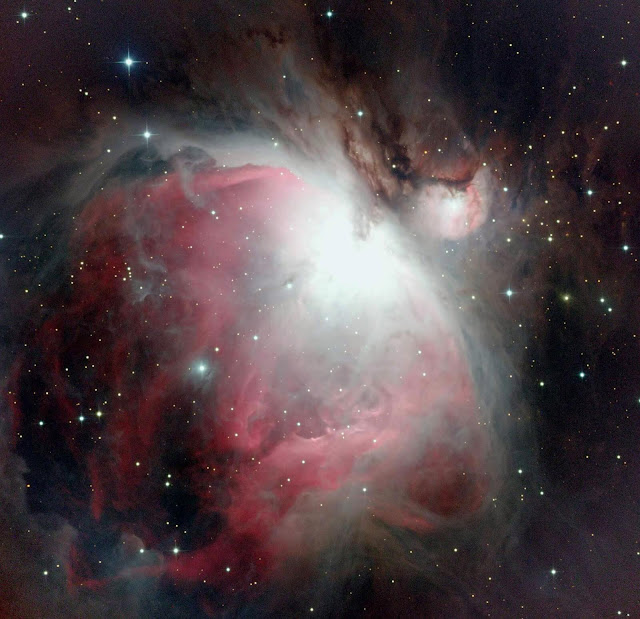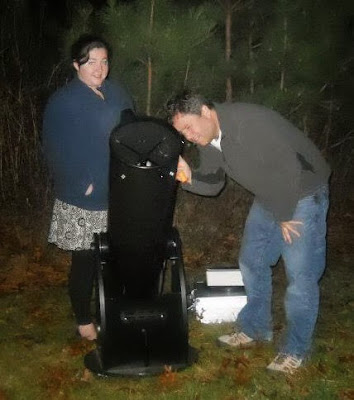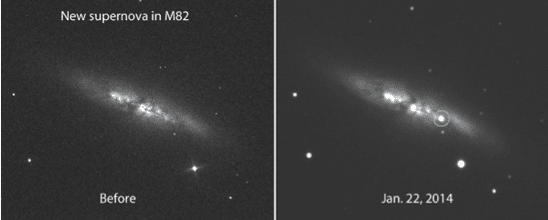M42, The Great Orion Nebula, is still one of my favorite deep-sky objects to image and visually observe. I recall seeing the nebula for the first time through my Sears and Roebuck 3" refracting telescope in the winter of 1979. I have to admit, it was a little disappointing how it looked as it didn't nearly compare to the pictures that were published in "Sky and Telescope" and "Astronomy" magazines at the time. However, it was still a bit exciting seeing the "fuzziness" of the object along with four major stars that make up the "Trapezium" in this brilliant stellar nursery. Due to the advanced technologies of remote robotic telescopes for education, capturing a detailed colored image of this fine object has become more possible.
On the morning of March 16, 2014, I logged in remotely around 6:00 am EDT to T31 (hosted by iTelescope.net in New South Wales, Australia - 9:00 pm, Australia time) from my home office on Cape Cod, Massachusetts. The moon was nearly full, however, the skies were very clear according to the image of their "All-Sky Camera". Telescope 31 was available, that is Planewave 20" (0.51m) CDK imaging telescope equipped with an FLI-PL09000 CCD camera. After consulting the Stellarium software on my iMac for a good object to image that is at least close to 60 degrees away from the moon, I saw that the constellation Orion was pretty much still high enough in the sky to allow me to image M42. I simply took four images in five minutes. Each image was taken with a Luminance, Red, Green, and Blue filter on the CCD camera. My colleague and friend Muir Evenden then downloaded the raw data from the iTelescope FTP site and proceeded to stack and process the four images using the CCD processing software named PixInsight. After Muir was done with his "pre-processing", I then performed a bit more processing in Photoshop CS6. We were amazed by the results of taking four 300-second exposures and just executing some quick processing with these powerful software packages.
Some Interesting Facts about M42:
The Orion Nebula (also known as Messier 42, M42, or NGC 1976) is a diffuse nebula situated south of Orion's Belt in the constellation of Orion. It is one of the brightest nebulae and is visible to the naked eye in the night sky. M42 is located at a distance of 1,344 ± 20 light-years and is the closest region of massive star formation to Earth. The M42 nebula is estimated to be 24 light-years across. It has a mass of about 2000 times the mass of the Sun. Older texts frequently refer to the Orion Nebula as the Great Nebula in Orion or the Great Orion Nebula.
The Orion Nebula is one of the most scrutinized and photographed objects in the night sky and is among the most intensely studied celestial features. The nebula has revealed much about the process of how stars and planetary systems are formed from collapsing clouds of gas and dust. Astronomers have directly observed protoplanetary disks, brown dwarfs, intense and turbulent motions of the gas, and the photo-ionizing effects of massive nearby stars in the nebula. There are also supersonic "bullets" of gas piercing the hydrogen clouds of the Orion Nebula. Each bullet is ten times the diameter of Pluto's orbit and tipped with iron atoms glowing bright blue. They have probably formed one thousand years ago from an unknown violent event.
Read More
 |
| M42 - Imaged by Michael Petrasko and Muir Evenden |
On the morning of March 16, 2014, I logged in remotely around 6:00 am EDT to T31 (hosted by iTelescope.net in New South Wales, Australia - 9:00 pm, Australia time) from my home office on Cape Cod, Massachusetts. The moon was nearly full, however, the skies were very clear according to the image of their "All-Sky Camera". Telescope 31 was available, that is Planewave 20" (0.51m) CDK imaging telescope equipped with an FLI-PL09000 CCD camera. After consulting the Stellarium software on my iMac for a good object to image that is at least close to 60 degrees away from the moon, I saw that the constellation Orion was pretty much still high enough in the sky to allow me to image M42. I simply took four images in five minutes. Each image was taken with a Luminance, Red, Green, and Blue filter on the CCD camera. My colleague and friend Muir Evenden then downloaded the raw data from the iTelescope FTP site and proceeded to stack and process the four images using the CCD processing software named PixInsight. After Muir was done with his "pre-processing", I then performed a bit more processing in Photoshop CS6. We were amazed by the results of taking four 300-second exposures and just executing some quick processing with these powerful software packages.
Some Interesting Facts about M42:
The Orion Nebula (also known as Messier 42, M42, or NGC 1976) is a diffuse nebula situated south of Orion's Belt in the constellation of Orion. It is one of the brightest nebulae and is visible to the naked eye in the night sky. M42 is located at a distance of 1,344 ± 20 light-years and is the closest region of massive star formation to Earth. The M42 nebula is estimated to be 24 light-years across. It has a mass of about 2000 times the mass of the Sun. Older texts frequently refer to the Orion Nebula as the Great Nebula in Orion or the Great Orion Nebula.
The Orion Nebula is one of the most scrutinized and photographed objects in the night sky and is among the most intensely studied celestial features. The nebula has revealed much about the process of how stars and planetary systems are formed from collapsing clouds of gas and dust. Astronomers have directly observed protoplanetary disks, brown dwarfs, intense and turbulent motions of the gas, and the photo-ionizing effects of massive nearby stars in the nebula. There are also supersonic "bullets" of gas piercing the hydrogen clouds of the Orion Nebula. Each bullet is ten times the diameter of Pluto's orbit and tipped with iron atoms glowing bright blue. They have probably formed one thousand years ago from an unknown violent event.






